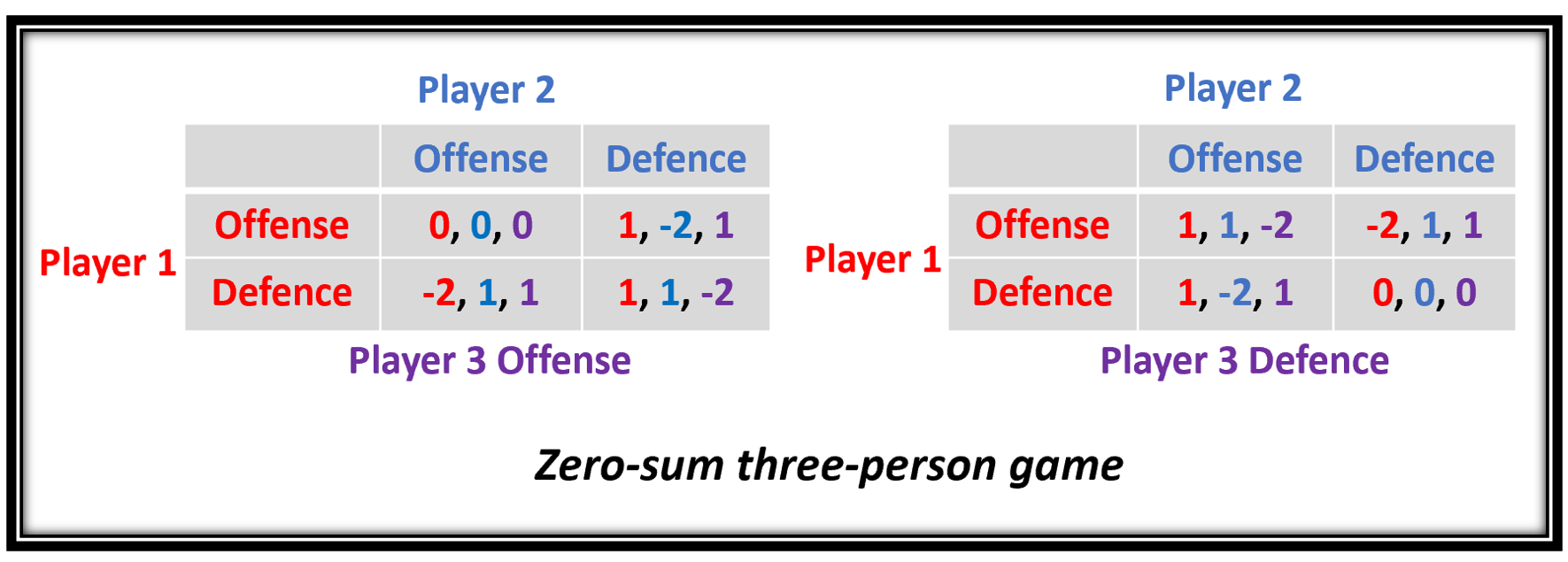|
Intransitive Game
An intransitive or non-transitive game is a zero-sum game in which pairwise competitions between the strategies contain a cycle. If strategy A beats strategy B, B beats C, and C beats A, then the binary relation "to beat" is intransitive, since transitivity would require that A beat C. The terms "transitive game" or "intransitive game" are not used in game theory. A prototypical example of an intransitive game is the game rock, paper, scissors. In probabilistic games like Penney's game, the violation of transitivity results in a more subtle way, and is often presented as a probability paradox. Examples * Rock, paper, scissors * Penney's game * Intransitive dice * ''Fire Emblem'', the video game franchise that popularized intransitive cycles in unit weapons: swords and magic beats axes and bows, axes and bows beat lances and knives, and lances and knives beat swords and magic See also * Stochastic transitivity Stochastic transitivity models are stochastic versions of the transiti ... [...More Info...] [...Related Items...] OR: [Wikipedia] [Google] [Baidu] |
Zero-sum Game
Zero-sum game is a Mathematical model, mathematical representation in game theory and economic theory of a situation that involves two competition, competing entities, where the result is an advantage for one side and an equivalent loss for the other. In other words, player one's gain is equivalent to player two's loss, with the result that the net improvement in benefit of the game is zero. If the total gains of the participants are added up, and the total losses are subtracted, they will sum to zero. Thus, Fair cake-cutting, cutting a cake, where taking a more significant piece reduces the amount of cake available for others as much as it increases the amount available for that taker, is a zero-sum game if marginal utility, all participants value each unit of cake equally. Other examples of zero-sum games in daily life include games like poker, chess, sport and Contract bridge, bridge where one person gains and another person loses, which results in a zero-net benefit for every ... [...More Info...] [...Related Items...] OR: [Wikipedia] [Google] [Baidu] |
Rock, Paper, Scissors
Rock, Paper, Scissors (also known by #Names, several other names and word orders) is an Intransitive game, intransitive hand game, usually played between two people, in which each player simultaneously forms one of three shapes with an outstretched hand. These shapes are "rock" (a closed fist: ✊), "paper" (a flat hand: ✋), and "scissors" (a fist with the index finger and middle finger extended, forming a V: ✌). The earliest form of "rock paper scissors"-style game originated in China and was subsequently imported into Japan, where it reached its modern standardized form, before being spread throughout the world in the early 20th century. A simultaneous game, simultaneous, zero-sum game, it has three possible outcomes: a draw, a win, or a loss. A player who decides to play rock will beat another player who chooses scissors ("rock crushes scissors" or "breaks scissors" or sometimes "blunts scissors"), but will lose to one who has played paper ("paper covers rock"); a play of ... [...More Info...] [...Related Items...] OR: [Wikipedia] [Google] [Baidu] |
Probability
Probability is a branch of mathematics and statistics concerning events and numerical descriptions of how likely they are to occur. The probability of an event is a number between 0 and 1; the larger the probability, the more likely an event is to occur."Kendall's Advanced Theory of Statistics, Volume 1: Distribution Theory", Alan Stuart and Keith Ord, 6th ed., (2009), .William Feller, ''An Introduction to Probability Theory and Its Applications'', vol. 1, 3rd ed., (1968), Wiley, . This number is often expressed as a percentage (%), ranging from 0% to 100%. A simple example is the tossing of a fair (unbiased) coin. Since the coin is fair, the two outcomes ("heads" and "tails") are both equally probable; the probability of "heads" equals the probability of "tails"; and since no other outcomes are possible, the probability of either "heads" or "tails" is 1/2 (which could also be written as 0.5 or 50%). These concepts have been given an axiomatic mathematical formaliza ... [...More Info...] [...Related Items...] OR: [Wikipedia] [Google] [Baidu] |
Penney's Game
Penney's game, named after its inventor Walter Penney, is a binary (head/tail) sequence generating game between two players. Player A selects a sequence of heads and tails (of length 3 or larger), and shows this sequence to player B. Player B then selects another sequence of heads and tails of the same length. Subsequently, a fair coin is tossed until either player A's or player B's sequence appears as a consecutive subsequence of the coin toss outcomes. The player whose sequence appears first wins. Provided sequences of at least length three are used, the second player (B) has an edge over the starting player (A). This is because the game is nontransitive such that for any given sequence of length three or longer one can find another sequence that has higher probability of occurring first. Analysis of the three-bit game For the three-bit sequence game, the second player can optimize their odds by choosing sequences according to: An easy way to remember the sequence is for th ... [...More Info...] [...Related Items...] OR: [Wikipedia] [Google] [Baidu] |
Paradox
A paradox is a logically self-contradictory statement or a statement that runs contrary to one's expectation. It is a statement that, despite apparently valid reasoning from true or apparently true premises, leads to a seemingly self-contradictory or a logically unacceptable conclusion. A paradox usually involves contradictory-yet-interrelated elements that exist simultaneously and persist over time. They result in "persistent contradiction between interdependent elements" leading to a lasting "unity of opposites". In logic, many paradoxes exist that are known to be invalid arguments, yet are nevertheless valuable in promoting critical thinking, while other paradoxes have revealed errors in definitions that were assumed to be rigorous, and have caused axioms of mathematics and logic to be re-examined. One example is Russell's paradox, which questions whether a "list of all lists that do not contain themselves" would include itself and showed that attempts to found set theory on ... [...More Info...] [...Related Items...] OR: [Wikipedia] [Google] [Baidu] |
Rock, Paper, Scissors
Rock, Paper, Scissors (also known by #Names, several other names and word orders) is an Intransitive game, intransitive hand game, usually played between two people, in which each player simultaneously forms one of three shapes with an outstretched hand. These shapes are "rock" (a closed fist: ✊), "paper" (a flat hand: ✋), and "scissors" (a fist with the index finger and middle finger extended, forming a V: ✌). The earliest form of "rock paper scissors"-style game originated in China and was subsequently imported into Japan, where it reached its modern standardized form, before being spread throughout the world in the early 20th century. A simultaneous game, simultaneous, zero-sum game, it has three possible outcomes: a draw, a win, or a loss. A player who decides to play rock will beat another player who chooses scissors ("rock crushes scissors" or "breaks scissors" or sometimes "blunts scissors"), but will lose to one who has played paper ("paper covers rock"); a play of ... [...More Info...] [...Related Items...] OR: [Wikipedia] [Google] [Baidu] |
Intransitive Dice
A set of dice is intransitive (or nontransitive) if it contains X>2 dice, ''X1'', ''X2'', and ''X3''... with the property that ''X1'' rolls higher than ''X2'' more than half the time, and ''X2'' rolls higher than ''X3'' etc... more than half the time, but where it is not true that ''X1'' rolls higher than ''Xn'' more than half the time. In other words, a set of dice is intransitive if the binary relation – rolls a higher number than more than half the time – on its elements is not transitive. More simply, ''X1'' normally beats ''X2'', ''X2'' normally beats ''X3'', but ''X1'' does not normally beat ''Xn''. It is possible to find sets of dice with the even stronger property that, for each die in the set, there is another die that rolls a higher number than it more than half the time. This is different in that instead of only "''A'' does not normally beat ''C''" it is now "''C'' normally beats ''A''". Using such a set of dice, one can invent games which are biased in ways th ... [...More Info...] [...Related Items...] OR: [Wikipedia] [Google] [Baidu] |
Fire Emblem
is a Video games in Japan, Japanese fantasy tactical role-playing game franchise developed by Intelligent Systems and published by Nintendo. First produced and published for the Nintendo Entertainment System in 1990, the series currently consists of seventeen core entries and five spinoffs. The core gameplay revolves around discrete battles between the player's team of characters and enemy Non-player character, non-player characters across grid-based maps. The player and enemy each take turns moving their characters across the map and having them perform combat-based actions. The games also feature a story and characters similar to traditional role-playing video games, and occasionally Social simulation game, social simulation aspects as well. A notable aspect of gameplay is the permanent death of characters in battle, rendering them unusable upon being defeated, although this aspect of the game can be turned off starting from ''Fire Emblem: New Mystery of the Emblem'' onward ... [...More Info...] [...Related Items...] OR: [Wikipedia] [Google] [Baidu] |
Stochastic Transitivity
Stochastic transitivity models are stochastic versions of the transitivity property of binary relations studied in mathematics. Several models of stochastic transitivity exist and have been used to describe the probabilities involved in experiments of paired comparisons, specifically in scenarios where transitivity is expected, however, empirical observations of the binary relation is probabilistic. For example, players' skills in a sport might be expected to be transitive, i.e. "if player A is better than B and B is better than C, then player A must be better than C"; however, in any given match, a weaker player might still end up winning with a positive probability. Tightly matched players might have a higher chance of observing this inversion while players with large differences in their skills might only see these inversions happen seldom. Stochastic transitivity models formalize such relations between the probabilities (e.g. of an outcome of a match) and the underlying transiti ... [...More Info...] [...Related Items...] OR: [Wikipedia] [Google] [Baidu] |





